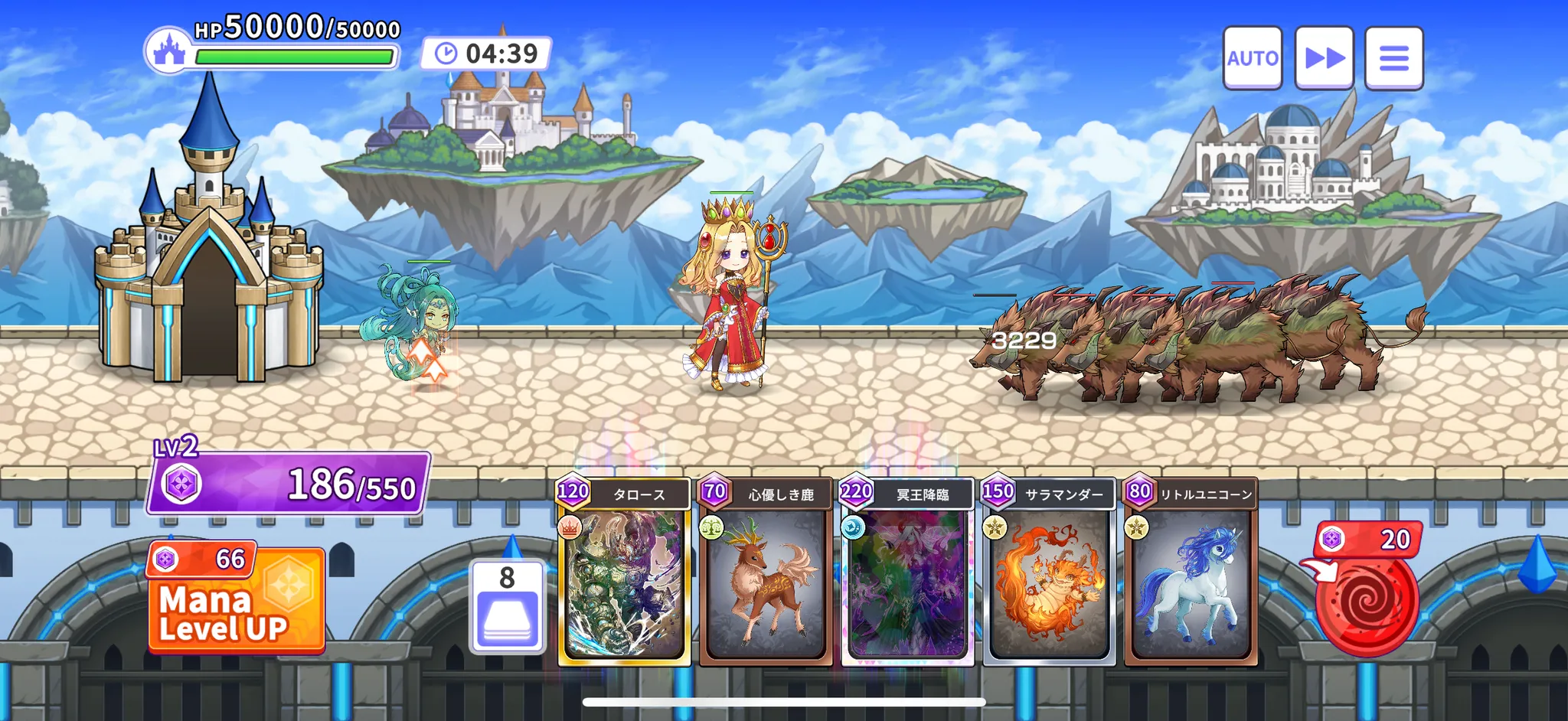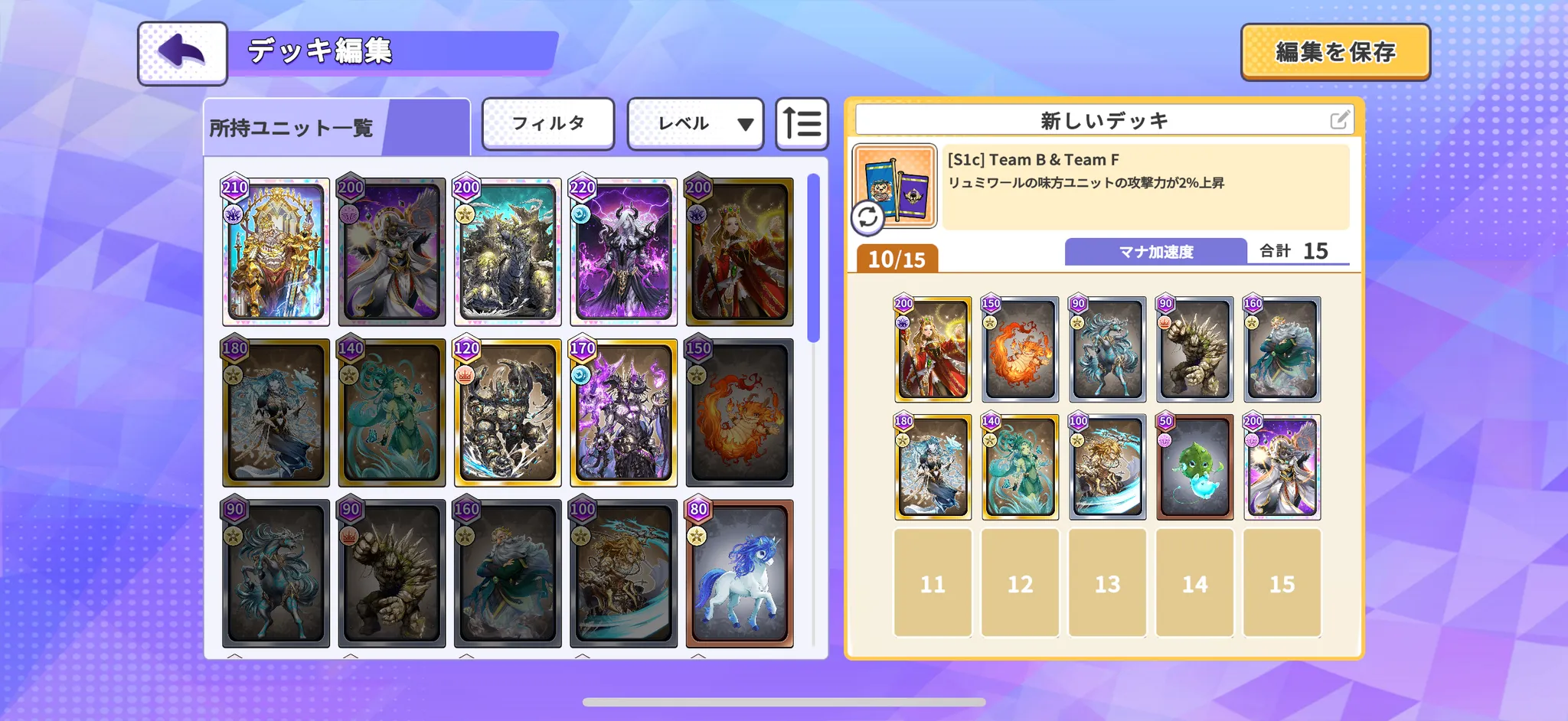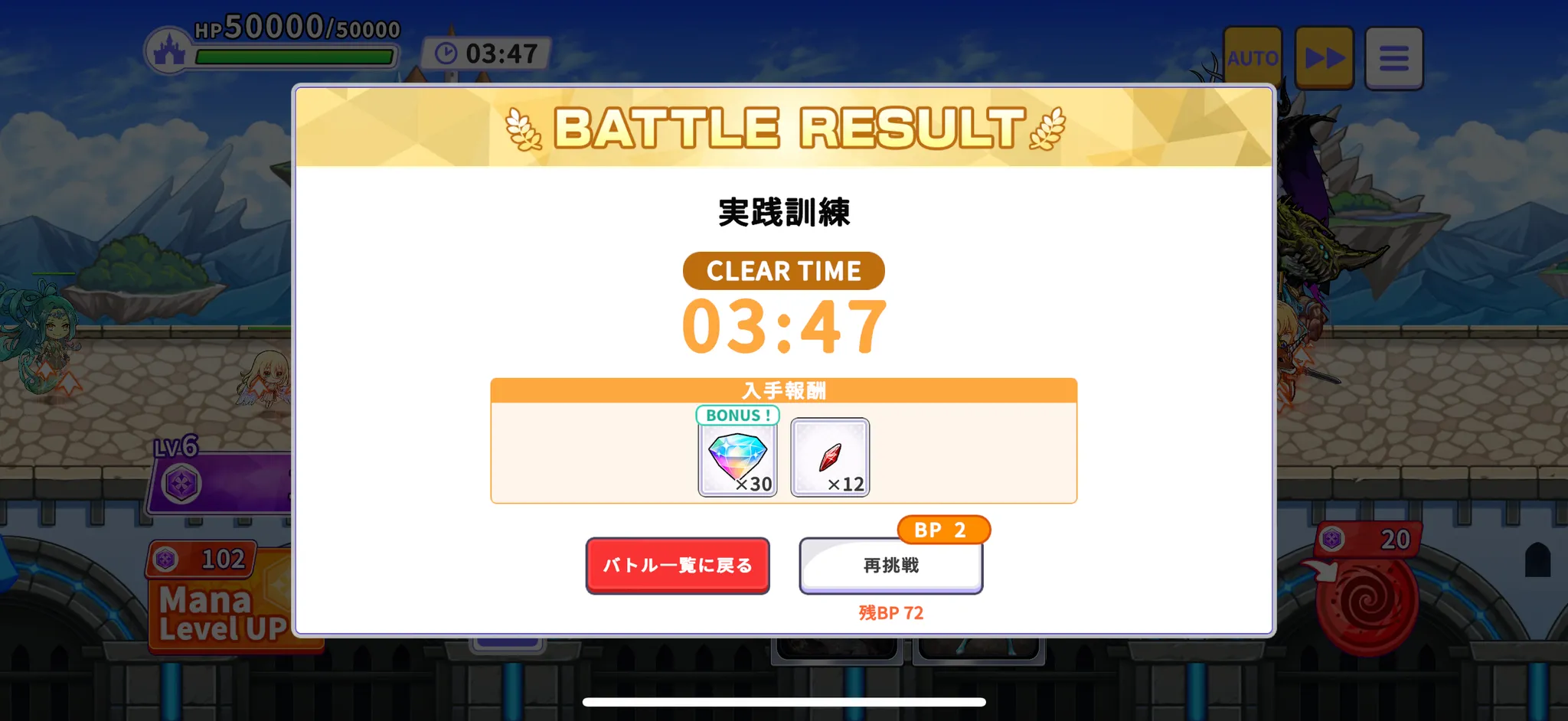Fan Activity in Your Spare Time! 3-Minute Heated Battles
The battle system of Community Wars is designed so that even amidst a busy daily life, your passionate desire to "do something for my fave" can be realized with just a fingertip.
Battles that conclude speedily in about 3 minutes per play are simple to enjoy with a single finger, just by tapping the screen to place units (cards). However, beneath this ease of use lies a deep gameplay that requires strategic judgment on which units to place and at what timing. Not only do results come out in a short time, but after the battle, your contributions (score, Medal acquisition status, etc.) are immediately tallied and reflected in the community rankings. The sense of accomplishment in "fan activity" that can be experienced in real time is also a major attraction of this game.
This chapter will explain in detail the basic rules of these heated tower defense battles, unit cards, and the resource management and development systems that support them.
Basic Controls and Battle Flow
Anyone can immediately enjoy the battles in "Community Wars" with intuitive controls. However, even in its simplicity, there's plenty of fun in strategizing. Here, we explain the basic controls and how battles proceed.

① Simple Controls Completed with a Single Finger: Deep Strategy
Basic battle controls are very simple. There is absolutely no need for complex command inputs or precise real-time unit control.
- Summoning Units:
- Select and tap the card of the unit you want to summon from the "unit cards" displayed in your hand (bottom of the screen).
- While checking the battle situation, tap the unit card again at the desired summoning timing, and the unit of the selected card will appear on the battlefield.
- Deciding which unit to send out and when is the first step in strategy.
- Automatic Unit Combat:
- Once summoned, units automatically move and attack according to their individual attack characteristics.
- Players do not need to direct the detailed movements of individual units and can focus on overseeing the entire battle situation and planning their next strategy (such as summoning additional units or Mana management).
- Mana Management:
- To summon a unit, you consume "Mana" displayed on the screen. Mana automatically accumulates gradually over time.
- Since powerful units require more Mana, resource management becomes important, such as deciding which unit to summon based on your available Mana, or whether to save Mana for the next powerful unit.
- You can also consume Mana to level up your Fort (your home base). Leveling up the Fort increases the Mana accumulation speed, making it easier to summon powerful units.
- You can also consume Mana to discard unit cards from your hand. Discarding cards will replenish your hand with new unit cards.
Even though the controls are simple, the accumulation of choices—which cards to choose, when to summon them, and how to use Mana—greatly influences the outcome of the battle.
② Basic Battle Flow: To Seize Victory
The basic progression of a battle is as follows. Understanding this flow and making accurate judgments according to the battle situation is the shortcut to victory.
- Battle Start and Enemy Invasion: When the battle begins, enemy units start advancing from the enemy camp (right edge of the field) towards your "Fort" (your home base). When hit by enemy attacks, the Fort's HP (Hit Points/Durability) decreases. Your objective is to defeat enemy units continuously to prevent the Fort's HP from reaching 0 and protect the Fort.
- Mana Accumulation and Fort Defense Preparation: "Mana" automatically accumulates over time. Prepare your Fort defense by deciding which units to summon using this Mana, in consultation with the unit cards in your hand.
- Building the Front Line: Strategically summon units to the field by consuming Mana. Summoned units automatically engage in combat, continuing to attack enemy units and halt their advance until they themselves are defeated.
- Intensifying Offense and Defense (Development through Automatic Combat): Your summoned units and enemy units engage in real-time offense and defense. The battle situation changes لحظه به لحظه, so always pay attention to the entire field.
- Clearing the Stage: Select and summon appropriate unit cards for each battle situation, defend your Fort from fierce enemy attacks, and defeat the oncoming enemy units one after another.
- Victory or Defeat (Clear Judgment):
- Victory Condition: Defeat all enemy units.
- Defeat Conditions: The Fort's HP reaches 0, or you fail to achieve the victory condition within the time limit.
- Battle Record Evaluation (Score Calculation): After the battle, a "Score" is calculated based on factors such as clear time, remaining Fort HP, and the number of enemy units defeated. Aiming for a high score is one of the joys of the game. (The relationship between score and Medals will be described later.)
[Insert Battle Flow Diagram Here]
The Key to Strategy: Unit Cards
To seize victory in "Community Wars" battles, a strategy of reading the battle situation and summoning the appropriate units is essential. The core of that strategy is the diverse "unit cards."

Each unit card has different characteristics and abilities. It is important to understand the main parameters a unit possesses and how they relate to strategy.
- Rarity:
- Rarities such as C (Common), R (Rare), SR (Super Rare), and UR (Ultra Rare) exist. Generally, higher rarity units tend to have higher basic abilities (stats) or possess powerful skills. However, some low-rarity units can also be effective in specific situations.
- Cost:
- Indicates the amount of "Mana" required to summon a unit to the field. High-performance units generally have a higher cost. You need to consider the overall cost balance of your deck and make judgments to summon units of appropriate cost according to the situation.
- Stats (HP, ATK, etc.):
- Represent basic combat abilities such as HP (Hit Points/Durability) and ATK (Attack/Attack Power). The higher these values, the tougher the unit or the more damage it can inflict on enemies.
- Skill:
- Each unit has unique special abilities. In addition to attack skills, there are various effects to advance the battle favorably, such as buff skills that temporarily increase allied stats or debuff skills that reduce enemy movement speed. Understanding the characteristics of skills and activating them at effective timings (many are auto-activated, but the actual activation timing can be adjusted by placement timing) is crucial.
- Attack Range:
- Each unit also has a different attack range, which determines how close they need to be to an enemy unit to attack. Using units with various attack ranges according to the enemy's formation and placement is key to conquering stages.
- Faction:
- All units are categorized into one of the following "Factions".
- Factions
- There are no direct ability differences or advantages based on fraction. However, some unit skills (refer to the Unit Guide for details) and the "Banner Items" explained in Chapter 5 have effects that can strengthen or target units of a specific fraction. When building a deck, the combination of fractions becomes a strategic element in addition to the individual abilities of the units.
Soleya

Direnne

Raguarof

Lumiwar

Crauwis

Tonua

ligael

Donamella

Currently, "Community Wars" battles do not employ a system of "attribute matchups" where certain attributes have advantages or disadvantages against others. Purely the performance of each unit, its skills, and above all, the player's own strategic judgment (unit combinations, placement timing, Mana management, etc.) determine the outcome. Find the optimal combination from a diverse range of unit cards that suits your strategy.
Resource Management and Development
To continuously grow stronger in "Community Wars," it is important to effectively manage "resources" to advance battles favorably and thoroughly "develop" your main units.

① BP (Battle Points): The Source of Daily Challenges
BP is like stamina consumed mainly to challenge "Normal Battles" (a game mode different from Community Battles).
- Consumption and Recovery: A certain amount of BP is consumed per Normal Battle, but BP automatically recovers over time.
- Main Uses and Benefits: By diligently participating in Normal Battles by consuming BP daily, you can obtain experience point items necessary for unit development. This forms the foundation of your force enhancement. Also, when you clear each stage for the first time, you can also obtain Gems, described later.
- Relation to Community Battles: Importantly, challenging the main event of this game, "Community Battles," generally does not consume BP. This allows players to concentrate on the strategy for Community Battles without worrying about BP.
② Gems: In-Game Currency Useful in Various Situations
Gems are a valuable in-game currency widely used in the world of "Community Wars."
- Main Acquisition Methods: Primarily obtained through in-game mission rewards, event rewards, login bonuses, and in-app purchases.
- Main Uses:
- Acquiring Unit Cards (Gacha): Used for Gacha to obtain new unit cards.
- Recovering BP: When BP is insufficient, Gems can be used to recover it instantly.
- Purchasing Development Items and Other Useful Items: Can be used to purchase items that accelerate unit development or various items that assist gameplay from the in-game shop, etc.
Using Gems strategically leads to efficient force enhancement.
③ Unit Development System: Towards Your Own Strongest Team
Unit cards you obtain can have their abilities further enhanced through development. Develop your favorite units or units core to your strategy and create your own powerful team.
- Level Up: You can raise a unit's level by consuming "Experience Point Items" obtained from battle rewards, mission rewards, or purchases from the in-game shop. When a unit's level increases, its basic stats such as HP and ATK are enhanced.
- Quantity Owned Bonus: By acquiring multiple copies of the same unit card, such as through duplicate Gacha pulls, a "Quantity Owned Bonus" occurs, further boosting that unit's basic performance. This allows even the same unit to grow into a more powerful individual.
④ Deck Building Points: The Starting Point of Strategy
Before challenging a battle, deciding which unit cards to combine to build a "Deck" is the first crucial point of strategy.

- Card Limit: There is an upper limit to the number of unit cards you can bring into a battle at one time (15 cards). Within this limit, you need to form a deck with a good balance of units for various roles, or specialized for a specific strategy.
- Same Name Card Restriction: You cannot include multiple copies of the same named unit card in a deck. Since even powerful unit cards cannot be included indefinitely, there is significance in developing a variety of cards.
- Mana Cost Balance: Considering the balance of the "Cost (Mana required for summoning)" of units in the entire deck is extremely important. Since available Mana is limited, a deck overly skewed towards high costs will result in stalled unit summoning.
- Utilizing Flag Items: By equipping "Flag items," detailed in Chapter 5, to your deck, you can enhance unit stats. This is also an important element of deck strategy.
About Score
When you clear each stage, a "Score" is calculated according to your battle performance. This score serves as one indicator of your own skill and can be a goal for achieving specific missions.

① Main Factors Affecting Score
The score is primarily determined by a comprehensive evaluation of the following factors:
- Clear Time: The faster you clear a stage, the higher your score tends to be. Speedy strategy is evaluated.
- Remaining Fort HP: The more Fort HP remaining at the end of the battle, the better the effect on your score. Solid defense is also important.
- Number and Types of Units Summoned: The number of units summoned during the battle and whether specific types of units were effectively utilized may also be subject to score evaluation. (Details may vary depending on game balance)
- Difficulty of Selected Stage: By challenging and clearing stages of higher difficulty, you have a chance to earn a higher score.
② Relationship Between Score and "Medals": Prioritizing Contribution to the Community
Aiming for a high score is one way to satisfy personal achievement and showcase your skills in rankings. However, in "Community Wars'" most important event, the "Community Battle," it is crucial to understand that the number of "Medals" acquired, rather than the individual score itself, determines the overall community ranking.
Medals are not just about getting a high score; they can be obtained by achieving diverse conditions such as:
- "Clearing a specific stage with exactly the target score (Just Score)"
- "Winning with a deck composed only of units of a specific rarity or type (Theme Deck Challenge)"
- "All community members clearing a specific stage a certain number of times or more (Community Challenge)"
(Details on Medal acquisition will be explained in Chapter 4).
In other words, while score is one barometer of individual skill and can be related to specific Medal acquisition conditions (e.g., Just Score), the core of this game is a "Medal system" that allows players of diverse playstyles to contribute to the community in their respective得意な ways.
Therefore, while being mindful of your score, the key to fully enjoying "Community Wars" is to always consider which actions will lead to acquiring the most Medals for your affiliated community's victory and play strategically.
Summary: Deep Strategic Battles Where Anyone Can Be a Hero
The battle system of Community Wars masterfully blends "simplicity," "strategy," and "diversity of contribution." While it features easy controls that even beginners can intuitively enjoy, it possesses a depth where the battle situation can change dramatically by being aware of unit characteristics, summoning timings, and unique Medal acquisition conditions.
The short gameplay duration is a welcome design that allows you to continue your "fan activities" even amidst a busy daily life. The accumulation of your small plays will eventually become a large contribution, leading to the victory of your fave community. Your strategy, beginning at your fingertips, will pave the way for your fave's future.
